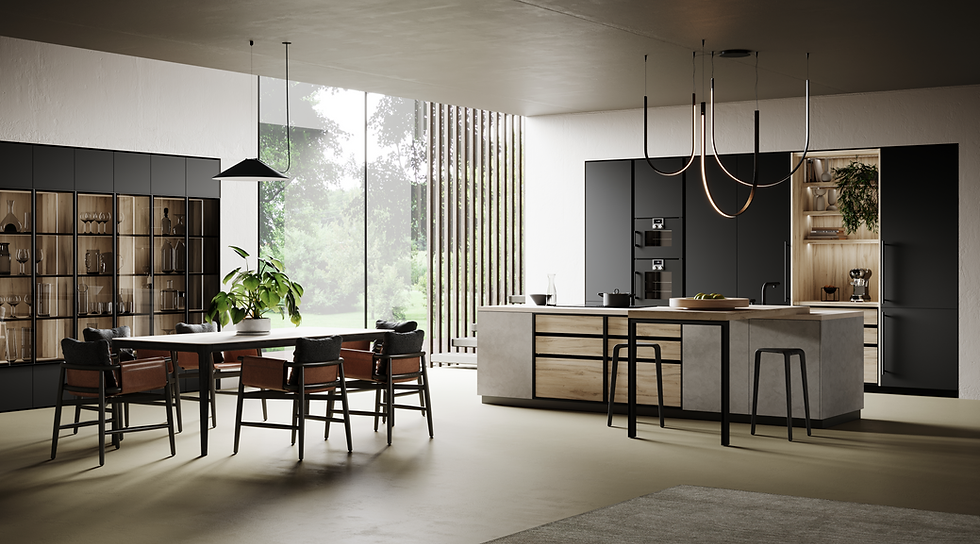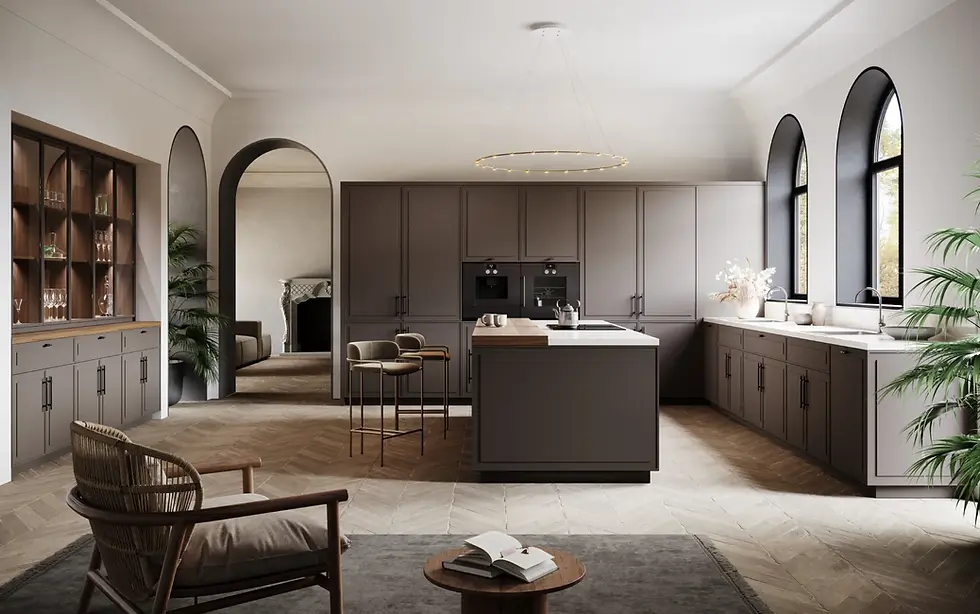Our Most Common FAQ; Dream Kitchen Cost
- Daniel

- Mar 10, 2023
- 4 min read
Updated: Mar 27, 2023
Even though we specialize in kitchen design and supplying the best European custom cabinetry that the world has to offer, many of our potential clients rely on us to help them answer this question and are not able to move forward with a cabinetry purchase until they have a clear understanding of how much the overall kitchen remodel is going to cost. Let’s get into it.

The 5 Major Components
There’s no easy answer, every kitchen remodel is different, and the scope of work (SOW) will vary drastically from one category to another. Feel free to take the information provided here and customize it for your kitchen. That said, there are five main components that most kitchen remodels will have in one way or another, and some additional smaller parts. These include: 1.) Design 2.) Contractor 3.) Cabinetry 4.) Counters, and 5.) Appliances. The smaller components are permit fees, plumbing fixtures, lighting, electrical, flooring, tile, doors, windows, and skylights.

01 Design
Even if you have a great idea for the layout of your space and the locations of the appliances aren’t changing much, if at all, there are still important design considerations.
A simple kitchen remodel requires that areas be brought up to current building codes, which may require electrical upgrades. New features like integrated LED lighting take planning, as does in-wall wood blocking to support the new wall cabinets. Specifications and drawings may be required by City-officials for the permitting process, and those usually need to be drawn by a professional. Our future blog post, To Permit or Not to Permit; That is the Question, will cover this subject in more detail.
An architect, engineer, interior designer, and various vendor experts may contribute to the design team for large projects. For much smaller projects with a less robust budget, it may be a collaboration between the homeowner and a kitchen design studio, such as ARTEZIA, to assist with cabinets and help with the appliance, countertop, plumbing, and other material selections. Total design costs can range from $5000 to $50,000 or more, depending on the project, the quality of the build, and the complexity involved.
02 Contractor
Once the designs are complete, a general contractor (GC) can provide an accurate price for the work. Often, contractors will include the costs for everything inside the walls, such as ‘rough plumbing and electrical,’ in their quotations. Everything outside the walls, called ‘finish materials,’ is on the customer’s end. The GC is the ultimate project manager, so it’s essential to find someone reputable and trustworthy and to make sure you compare apples-to-apples in the estimates when making your decision.
It varies by location, but in a metropolitan area like San Francisco, a GC will usually charge between $30,000 to $80,000 for a kitchen remodel, but that absolutely depends on the SOW, as the fees could be substantially more if there are structural concerns, complicated site conditions, and/or high-end finishes and details.

03 Cabinetry
This is our field of expertise and where we shine. European cabinetry is typically in line with high-quality local custom cabinetry rates, though some folks charge more. Smaller kitchens can range from $30,000 to $50,000, medium-sized kitchens from $40,000 to $75,000, and larger spaces from $50,000 to $95,000+. Remember that these are starting points, not including sales tax, shipping, delivery, design, or installation.
Higher-end cabinetry like TEAM 7 will cost more, it’s a special product. More on this in a future blog article, “Wood is Good; TEAM 7 and the Future of ARTEZIA.” When working on your kitchen, once we have an idea of the general layout, the finishes involved, and the preferred manufacturer, we’re able to provide a ballpark price that will be in the +/-20% range so you can decide if you’d like to move forward with one of our design service packages.
04 Counters
As you may have noticed, any of these sub headers could be entire blog posts themselves, as there are so many details; the same can be said for counters and backsplashes. Whether one chooses natural stone or engineered surfaces, the cost of the material, fabrication, and installation for counters and backsplashes will depend on many factors, a significant one being the number of slabs required. A countertop with a 4-inch-tall backsplash in a smaller or medium-sized kitchen may only cost $10,000. Typically, our clients spend $15,000 to $25,000 or more for engineered stone counters with matching backsplash material that extends the full height from the counters to the bottom of the wall cabinets. Once your designer has produced the final drawings for your kitchen, you can request bids from local suppliers. As with every category on this list, service quality counts, as it varies considerably amongst vendors. We have our favorite local suppliers, and we’re happy to make an introduction when the time comes.

05 Appliances
Again, this category requires much more than a paragraph, but the biggest ticket purchases on the appliance list are the fridge/freezer and the range or cooktop and wall oven combination. Other items like the hood fan, dishwasher, microwave or speed oven, and other alternatives, such as wine fridges and coffee machines, add up. Typically our clients spend $25,000 +/- for a Miele suite of appliances, but as with everything, it is always easy to pay more. Folks that keep their existing fridge or opt for non-integrated options can save money, as obtaining good-quality items for less is possible.
Additional Costs
Additional costs may include City permitting fees, plumbing fixtures, flooring, electrical, doors, windows, and any tile work you may have. In working with your designer, I recommend making a comprehensive list – you will save time and potentially costly mistakes. As kitchen design experts and custom cabinetry professionals, we rely on our trade colleagues in these various fields to keep us updated on the current options and possibilities ourselves. The more folks you can bring into your circle to help with the details and the more time and attention you have for the design process, the better the outcome will be.




Comments